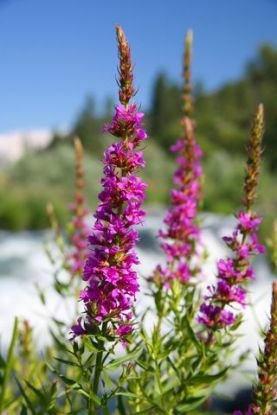Purple Loosestrife
|
Purple Loosestrife - There are different species of Loosestrife yet describing one is as if to describe many. |

|
"Loosestrife" is found in two plant families, Primulaceae and Lythraceae.
-
Primulaceae is the Primrose flower family. Yellow Loosestrife is in genus Lysimachia. These are different than those in the Lythraceae family.
-
Lythraceae is the second family and discussed on this page.
This entire Lythraceae family is Loosestrife, which has about 38 genera, including the genus Lythrum which includes the very commercial Purple Loosestrife (Lythrum salicaria). Many genera are aggressive and invasive outside of their native environments.
Lythraceae are mostly shrubby perennials, herbs and small trees whereas Primulaceae is a more herbaceous perennial.
Lythraceae is native to sub-tropical regions, and also grows across Great Britain, Europe to central Russia, South America and Africa, Northern India, China and Japan.
|
It has become a problem throughout all the United States and is now making it's way north to Canada along with other areas around the world, including New Zealand. |

|
Gardeners grow this as a garden perennial unaware that it needs to be highly controlled. In time weed grows out of control and many states now have outlawed it for sale and/or use of it as a garden flower.
This weed thrives in moist environments but adapt to a wide range of soils, especially wet and swampy areas along with the sun. It spreads by seed and one mature plant can produce anywhere between 2 - 2.5 million seeds annually. Seeds remain dormant in many different soil temperatures for years.
This weed will crowd out less aggressive native plants that are critical for local eco-systems, eventually reducing biological diversity and destroying wildlife habitats of all kinds,
including pollinators such as butterflies.
Upright stems are stiff, slightly hairy and grow anywhere from 2-4 feet tall. They are usually four-sided but sometimes they appear six-sided. Leaves are lanced shaped, grow opposite of each other on stem and are larger at the base, narrowing at top as weed grows.
|
Each individual flower has 6 petals and in most areas of the country blooms mid-summer through fall. |

|
Young tender plants can easily be pulled, along with it's root if pulling from moist soil. It will likely break off if soil is dry.
If plants are mature, dig out the plant and roots. Make sure this is done before any flowers bloom. If weed blooms, cut flower spikes off - avoid shaking them. Carefully place them in garbage.
Other manual options include burning weeds, but do so carefully. Mowing depletes energy where root will eventually die if weed seeds get into the lawn.
Pre-emergent herbicides are effective on weed seeds and post-emergent weed control helps if plants are above soil line.
Once under control consider inorganic mulch and other organic mulch types.
FYI:
- It is unclear how any loosestrife came to North America. Stories for purple loosestrife include it came over as an ornamental plant that also offered medicinal properties. Other stories tell of how it was used as ballast for sailing ships.
- There have been various methods of introducing biological control, but so far findings have been proven to off-set the balance of local eco-systems. Experimentation continues.
Related Articles:
Back from Purple Loosestrife to Weed Identification
Back from Purple Loosestrife to Easy Butterfly Garden.com
 Copyright © 2010-2022 Easy-Butterfly-Garden.com
Copyright © 2010-2022 Easy-Butterfly-Garden.com
Privacy Policy Disclaimer

Join Easy Butterfly Garden on Facebook
Recent Articles
-
Annual Bluegrass
Jan 14, 17 08:14 PM
Annual bluegrass (Poa annua) is considered a weed in the Poa family, which has a few popular turf grasses. If this gets into your butterfly garden listed are a few ways to eradicate it.
-
Candytuft Flowers
Sep 25, 16 10:54 PM
There are the annual, or Iberis, candytuft flowers and also perennials which are called Iberis sempervirens.
-
Keeping Deer Out
Sep 19, 16 01:10 PM
Reviewing the types of products available for keeping deer out of our gardens along with building fences. Many of these products help with other garden pests.
-
Butterfly Meadows
Sep 19, 16 12:52 PM
Compared to other wildlife gardening, butterfly meadows take time and are not for the faint of heart.
-
Natural Gardening
Sep 19, 16 12:32 PM
Natural gardening includes different types of gardens. These garden types create a casual, natural envirionment and help sustain native wildlife which includes butterflies.






New! Comments
Have your say about what you just read! Leave me a comment in the box below.